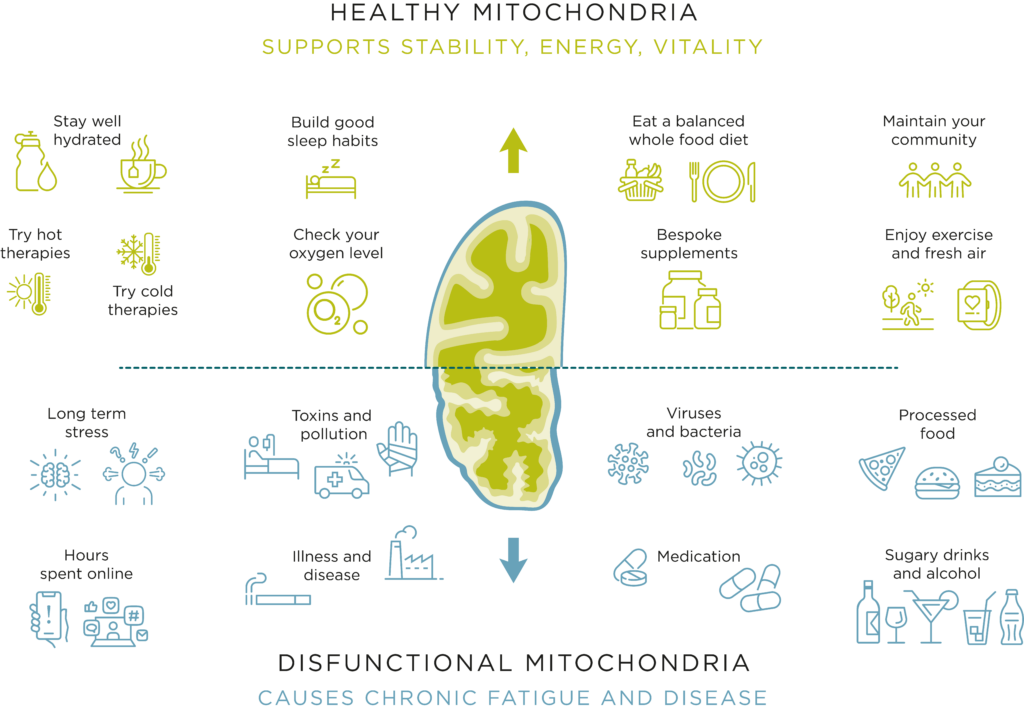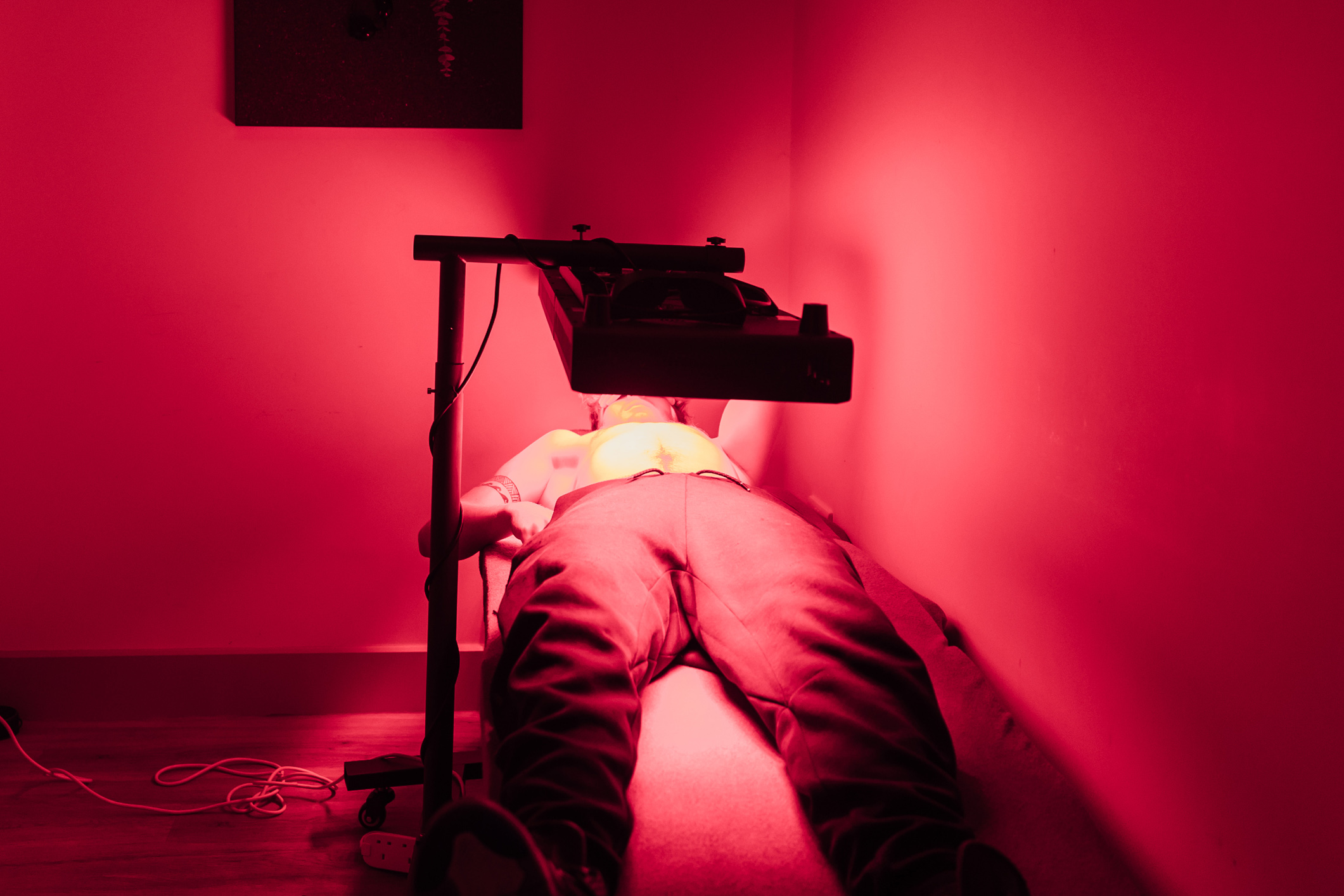What are mitochondria? Mitochondria are the powerhouses of our cells
It’s likely that you haven’t given much thought to mitochondria since your biology lessons at school. Can you recall the function of mitochondria?
Fear not, this is not a pop quiz! Below we’re sharing what mitochondria are, the role they have within the body, what can happen if the body has poor mitochondrial function and how we can use Functional and Integrated Medicine to improve it.
Optimal mitochondrial performance is an essential component in living a healthy, well-energised and vibrant life.
Settle in for a refresher on these indispensable powerhouses.
Mitochondria are the powerhouses of our cells. They are the structures responsible for creating energy within every cell in the body. That energy is called adenosine triphosphate, commonly known as ATP. We require ATP to complete every function within the body: detoxing, building new tissue, thinking, moving, walking, to reproduce… the list goes on. Simply put, if there is no ATP, there is no life. We’re not able to energise our cells to do anything without it.
As our founder and lead practitioner Dr Laurens Maas shares: “It is vitally important that people look after their mitochondria and influence them for the better so that they can reproduce (the mitochondria) within our cells to give us lots of energy.”
Mitochondrial imbalances

At The Maas Clinic, our Osteopathic, Functional and Integrated Medicine practice, we come across many clients who have mitochondrial imbalances. “Mitochondriopathy” is the term given to when something has gone wrong with the mitochondria.
Mitochondrial imbalances can occur for a number of reasons, including:
- exposure to chemicals
- exposure to toxins
- vaccines
- oxidative stress
- use of antibiotics
- genetics
A note on antibiotics; anything that can damage a bacteria, such as an antibiotic, can also damage the mitochondria. Mitochondria carry DNA that’s originally from bacteria, therefore anything designed to damage bacteria will also have an impact on mitochondria. Many people that take long-term antibiotics find themselves suffering with chronic fatigue, which is linked to poor mitochondrial function.
How do you know if your mitochondria are off? What symptoms can you look out for?
Chronic fatigue is the #1 symptom of mitochondrial dysfunction.
If the “powerhouses of your cells” are not able to create sufficient energy, then it’s logical that you’ll feel a lack of get-up-and-go.
Do your limbs feel heavy? Is it a struggle to feel rested? Is everything exhausting?
A tell-tale sign is when habits like house chores, exercise and getting up to go to work, feel significantly harder. You simply “don’t have the energy”.
Individuals who have chronic energy losses and experience long term chronic fatigue are more likely to suffer with neurodegenerative diseases, heart disease and liver disease. Each of these structures—the nervous system, the heart, the liver—require enormous amounts of energy to keep going. In other words, they require a lot of ATP. If they’re not receiving it, it can lead to illness.
Let’s look more closely at an organ which requires a large amount of ATP – the heart.
A healthy heart beats every second and adapts to our movements—exercise, going up the stairs, running for a bus. A healthy heart is able to replace its ATP (the energy) within seconds. Incredible!
When the heart’s ability to replace its ATP slows down, for example from every 10 seconds to every 12 seconds to every 15 seconds, it can indicate the beginning of heart disease. The heart muscle cells do not have enough mitochondria producing energy to create the contractions required of the heart, this is a fatigue response. An ongoing fatigue response can weaken the organ’s function, leading to disease.
Factors that affect your mitochondria in a positive and negative way

Can you take a test for mitochondria function?
At The Maas Clinic we use an Organix Test which is able to detect if there are problems in the chain reactions of the mitochondria. This is a urine analysis test which can be completed in the clinic. The chain reactions which happen within the mitochondria can be assessed by analysing the metabolic byproducts within the urine.
We also use a Metabolics DNA Test. This is a urine genetic analysis test, which again can be completed in the clinic.
We use these tests in conjunction with our clients’ symptoms, to assess mitochondrial function.
We may also suggest further testing to get a broader profile of a client’s biochemistry.
How can you positively impact your mitochondria?



Reducing your overall oxidative stress profile will help your mitochondria to function better.
Here are a few behavioural strategies you can use to improve your mitochondria function:
- cold immersion—this can include a cold shower finish, ice baths and open-water swimming
- exercise—find a form which you enjoy and which is achievable for you, you can start with a daily walk and build up from there
- avoiding processed foods—cooking from fresh is the gold standard
- eating organic foods—therefore limiting exposure to chemicals and other toxins
- fasting—this can help the mitochondria to regenerate
- using infrared light—this is particularly useful for people with chronic fatigue syndrome, you can purchase an infrared light for your home, increase your sunlight exposure (being mindful of UVA and UVB rays) or find a practice which offers infrared light treatment, like The Maas Clinic
Please note: any new habits should be approached in a mindful and safety conscious way. If embarking on new intense behaviours such as cold immersion and fasting, we advise seeking the guidance of an expert and/or trusted practitioner.




Supplements to support the mitochondria
- L-Carnitine
- Methylene Blue
- NT Factors
- Mitochondrial Resuscitate
- CoQ10
- Vitamin Bs
- Vitamin D
- Omega Oils
- L-Glutathione
- Vitamin C
Please note: At The Maas Clinic we create bespoke supplement plans for every client based on their unique biochemistry. The list above is an example of supplements we have found useful in mitochondrial recovery; it is not designed to act as guidance for your own supplement intake. If you would like to discuss your unique supplement needs, please reach out to our friendly team to book a consultation.
Mitochondria and the skin
Healthy mitochondria is “fluffed-up” and smooth. Conversely, mitochondria with energy deficits appear crinkled—like a crushed drink can. The difference in the appearance of the mitochondria can be seen in your skin.
When the mitochondria are working well, skin appears plumped-up and youthful-looking. When the mitochondria are not functioning well, skin can appear sallow and drawn.
In Ancient Chinese Medicine the skin is an important indicator of health and vitality. By the time something manifests in the skin, it indicates a chronic condition.


Mitochondria and the brain
Here at The Maas Clinic we use a specialist infrared light helmet to treat clients who’re suffering with mitochondria conditions pertaining to brain health.
Conditions we can treat using the infrared light helmet include:
- autism
- brain injuries
- depression
- pain
- Parkinson’s disease
Swaps for better mitochondria function
If you are craving sugar… reach for protein or healthy fats.
If you are craving starch… opt for a “better” starch like carrots, or a resistant starch like cooked and cooled rice, cooked and cooled potatoes, oats, beans and legumes.
If you are craving a sugary drink . . . go for green tea, black coffee, sparkling water or rhubarb water (we like dash water’s rhubarb flavour). Green tea, black coffee and rhubarb can help to manage appetite.
NB: if you are drinking green tea or coffee, adding any kind of milk will change its profile. When consumed without milk, green tea and coffee are lipolytic (they help to manage appetite), adding milk stops them from being so. You can however add MCT (coconut) oil, butter or cream to coffee and it remains lipolytic.

Mitochondria recovery at The Maas Clinic
Our mitochondria recovery programme can be embarked upon in isolation or layered in as part of a wider treatment programme. Our practitioners will advise on what’s most appropriate for each individual client.
The Maas Clinic mitochondria recovery programme includes:
- testing to determine the health of the mitochondria and establish a baseline, including an Organix Testand Metabolics DNA Test
- a bespoke treatment programme which can include infrared light therapy, supplements, lifestyle changes, bioressonace and ONDAMED therapy
- re-testing at 2-3 months to check in on progress
We advise allowing for 2 – 3 months to completely reboot the mitochondria.
Ongoing support
Once you’ve pressed “re-set” on your mitochondria with us, our hope is that your new “healthy life” becomes the norm. As with all of our treatment programmes, we advise our clients on ongoing diet, lifestyle and mindset shifts which can help them to maintain vibrant health.
In the case of mitochondria recovery this can include:
- regular infrared light exposure
- an ongoing supplement routine
- exposure to sunlight
- grounding
- hydration via high-quality water—filtered water or glass bottled water are our preference
- high doses of Vitamin C when exposed to radiation, for example when having an x-ray taken
“Fix the mitochondria and everything improves”
Dr Laurens Maas
Improving mitochondrial function will have a positive ripple effect across all systems and functions within the body. Healthy mitochondria help our whole body to function with energy, vitality and stability. Energy is used for everything: digestion, detoxification, brain function, sleep, laughing, loving …it all relies on electrons. And electrons rely on the mitochondria.
If you think that you may be suffering with a mitochondria issue, we can help.
We are passionate about unpicking our clients’ health concerns and it is our number one focus to help our clients to achieve their optimal health.
For more information ask our clinic team.

 Phoenix Maas
Phoenix Maas Our Team
Our Team